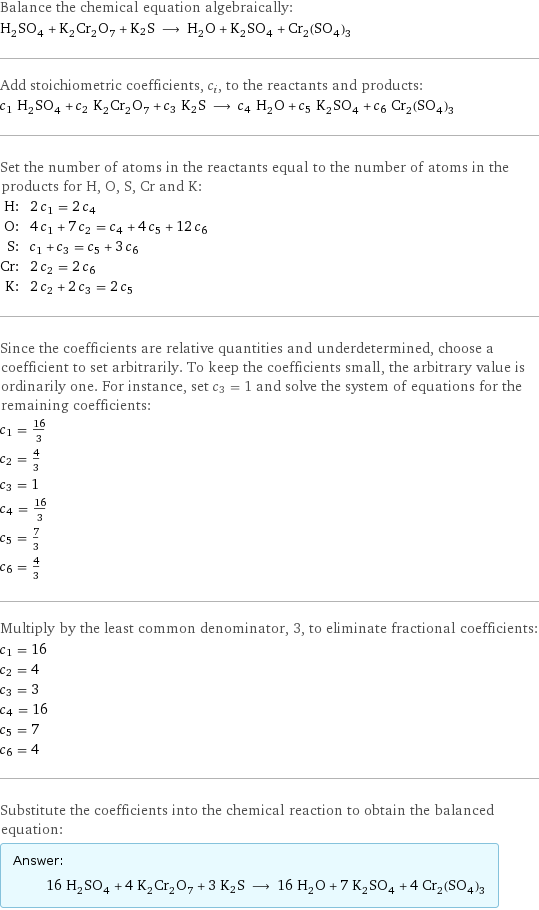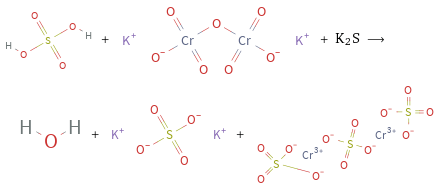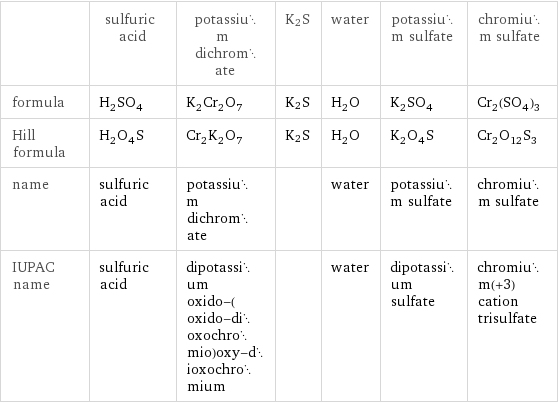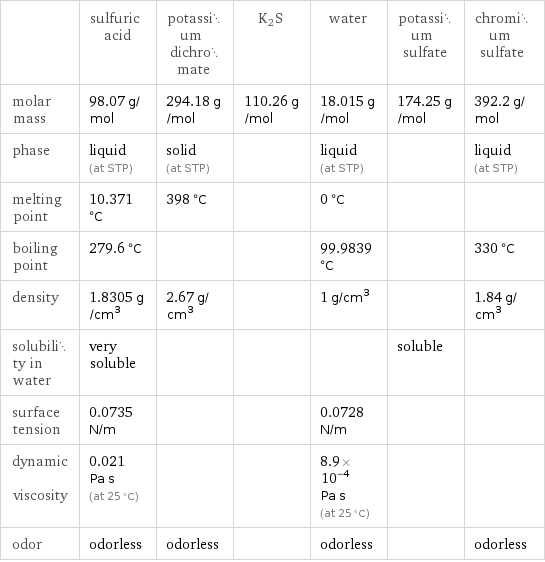Input interpretation

H_2SO_4 sulfuric acid + K_2Cr_2O_7 potassium dichromate + K2S ⟶ H_2O water + K_2SO_4 potassium sulfate + Cr_2(SO_4)_3 chromium sulfate
Balanced equation

Balance the chemical equation algebraically: H_2SO_4 + K_2Cr_2O_7 + K2S ⟶ H_2O + K_2SO_4 + Cr_2(SO_4)_3 Add stoichiometric coefficients, c_i, to the reactants and products: c_1 H_2SO_4 + c_2 K_2Cr_2O_7 + c_3 K2S ⟶ c_4 H_2O + c_5 K_2SO_4 + c_6 Cr_2(SO_4)_3 Set the number of atoms in the reactants equal to the number of atoms in the products for H, O, S, Cr and K: H: | 2 c_1 = 2 c_4 O: | 4 c_1 + 7 c_2 = c_4 + 4 c_5 + 12 c_6 S: | c_1 + c_3 = c_5 + 3 c_6 Cr: | 2 c_2 = 2 c_6 K: | 2 c_2 + 2 c_3 = 2 c_5 Since the coefficients are relative quantities and underdetermined, choose a coefficient to set arbitrarily. To keep the coefficients small, the arbitrary value is ordinarily one. For instance, set c_3 = 1 and solve the system of equations for the remaining coefficients: c_1 = 16/3 c_2 = 4/3 c_3 = 1 c_4 = 16/3 c_5 = 7/3 c_6 = 4/3 Multiply by the least common denominator, 3, to eliminate fractional coefficients: c_1 = 16 c_2 = 4 c_3 = 3 c_4 = 16 c_5 = 7 c_6 = 4 Substitute the coefficients into the chemical reaction to obtain the balanced equation: Answer: | | 16 H_2SO_4 + 4 K_2Cr_2O_7 + 3 K2S ⟶ 16 H_2O + 7 K_2SO_4 + 4 Cr_2(SO_4)_3
Structures

+ + K2S ⟶ + +
Names

sulfuric acid + potassium dichromate + K2S ⟶ water + potassium sulfate + chromium sulfate
Equilibrium constant
![Construct the equilibrium constant, K, expression for: H_2SO_4 + K_2Cr_2O_7 + K2S ⟶ H_2O + K_2SO_4 + Cr_2(SO_4)_3 Plan: • Balance the chemical equation. • Determine the stoichiometric numbers. • Assemble the activity expression for each chemical species. • Use the activity expressions to build the equilibrium constant expression. Write the balanced chemical equation: 16 H_2SO_4 + 4 K_2Cr_2O_7 + 3 K2S ⟶ 16 H_2O + 7 K_2SO_4 + 4 Cr_2(SO_4)_3 Assign stoichiometric numbers, ν_i, using the stoichiometric coefficients, c_i, from the balanced chemical equation in the following manner: ν_i = -c_i for reactants and ν_i = c_i for products: chemical species | c_i | ν_i H_2SO_4 | 16 | -16 K_2Cr_2O_7 | 4 | -4 K2S | 3 | -3 H_2O | 16 | 16 K_2SO_4 | 7 | 7 Cr_2(SO_4)_3 | 4 | 4 Assemble the activity expressions accounting for the state of matter and ν_i: chemical species | c_i | ν_i | activity expression H_2SO_4 | 16 | -16 | ([H2SO4])^(-16) K_2Cr_2O_7 | 4 | -4 | ([K2Cr2O7])^(-4) K2S | 3 | -3 | ([K2S])^(-3) H_2O | 16 | 16 | ([H2O])^16 K_2SO_4 | 7 | 7 | ([K2SO4])^7 Cr_2(SO_4)_3 | 4 | 4 | ([Cr2(SO4)3])^4 The equilibrium constant symbol in the concentration basis is: K_c Mulitply the activity expressions to arrive at the K_c expression: Answer: | | K_c = ([H2SO4])^(-16) ([K2Cr2O7])^(-4) ([K2S])^(-3) ([H2O])^16 ([K2SO4])^7 ([Cr2(SO4)3])^4 = (([H2O])^16 ([K2SO4])^7 ([Cr2(SO4)3])^4)/(([H2SO4])^16 ([K2Cr2O7])^4 ([K2S])^3)](../image_source/5e864ea606a13ac51b33029c70c552bb.png)
Construct the equilibrium constant, K, expression for: H_2SO_4 + K_2Cr_2O_7 + K2S ⟶ H_2O + K_2SO_4 + Cr_2(SO_4)_3 Plan: • Balance the chemical equation. • Determine the stoichiometric numbers. • Assemble the activity expression for each chemical species. • Use the activity expressions to build the equilibrium constant expression. Write the balanced chemical equation: 16 H_2SO_4 + 4 K_2Cr_2O_7 + 3 K2S ⟶ 16 H_2O + 7 K_2SO_4 + 4 Cr_2(SO_4)_3 Assign stoichiometric numbers, ν_i, using the stoichiometric coefficients, c_i, from the balanced chemical equation in the following manner: ν_i = -c_i for reactants and ν_i = c_i for products: chemical species | c_i | ν_i H_2SO_4 | 16 | -16 K_2Cr_2O_7 | 4 | -4 K2S | 3 | -3 H_2O | 16 | 16 K_2SO_4 | 7 | 7 Cr_2(SO_4)_3 | 4 | 4 Assemble the activity expressions accounting for the state of matter and ν_i: chemical species | c_i | ν_i | activity expression H_2SO_4 | 16 | -16 | ([H2SO4])^(-16) K_2Cr_2O_7 | 4 | -4 | ([K2Cr2O7])^(-4) K2S | 3 | -3 | ([K2S])^(-3) H_2O | 16 | 16 | ([H2O])^16 K_2SO_4 | 7 | 7 | ([K2SO4])^7 Cr_2(SO_4)_3 | 4 | 4 | ([Cr2(SO4)3])^4 The equilibrium constant symbol in the concentration basis is: K_c Mulitply the activity expressions to arrive at the K_c expression: Answer: | | K_c = ([H2SO4])^(-16) ([K2Cr2O7])^(-4) ([K2S])^(-3) ([H2O])^16 ([K2SO4])^7 ([Cr2(SO4)3])^4 = (([H2O])^16 ([K2SO4])^7 ([Cr2(SO4)3])^4)/(([H2SO4])^16 ([K2Cr2O7])^4 ([K2S])^3)
Rate of reaction
![Construct the rate of reaction expression for: H_2SO_4 + K_2Cr_2O_7 + K2S ⟶ H_2O + K_2SO_4 + Cr_2(SO_4)_3 Plan: • Balance the chemical equation. • Determine the stoichiometric numbers. • Assemble the rate term for each chemical species. • Write the rate of reaction expression. Write the balanced chemical equation: 16 H_2SO_4 + 4 K_2Cr_2O_7 + 3 K2S ⟶ 16 H_2O + 7 K_2SO_4 + 4 Cr_2(SO_4)_3 Assign stoichiometric numbers, ν_i, using the stoichiometric coefficients, c_i, from the balanced chemical equation in the following manner: ν_i = -c_i for reactants and ν_i = c_i for products: chemical species | c_i | ν_i H_2SO_4 | 16 | -16 K_2Cr_2O_7 | 4 | -4 K2S | 3 | -3 H_2O | 16 | 16 K_2SO_4 | 7 | 7 Cr_2(SO_4)_3 | 4 | 4 The rate term for each chemical species, B_i, is 1/ν_i(Δ[B_i])/(Δt) where [B_i] is the amount concentration and t is time: chemical species | c_i | ν_i | rate term H_2SO_4 | 16 | -16 | -1/16 (Δ[H2SO4])/(Δt) K_2Cr_2O_7 | 4 | -4 | -1/4 (Δ[K2Cr2O7])/(Δt) K2S | 3 | -3 | -1/3 (Δ[K2S])/(Δt) H_2O | 16 | 16 | 1/16 (Δ[H2O])/(Δt) K_2SO_4 | 7 | 7 | 1/7 (Δ[K2SO4])/(Δt) Cr_2(SO_4)_3 | 4 | 4 | 1/4 (Δ[Cr2(SO4)3])/(Δt) (for infinitesimal rate of change, replace Δ with d) Set the rate terms equal to each other to arrive at the rate expression: Answer: | | rate = -1/16 (Δ[H2SO4])/(Δt) = -1/4 (Δ[K2Cr2O7])/(Δt) = -1/3 (Δ[K2S])/(Δt) = 1/16 (Δ[H2O])/(Δt) = 1/7 (Δ[K2SO4])/(Δt) = 1/4 (Δ[Cr2(SO4)3])/(Δt) (assuming constant volume and no accumulation of intermediates or side products)](../image_source/770a73ec6d7af95702b95aee0117f197.png)
Construct the rate of reaction expression for: H_2SO_4 + K_2Cr_2O_7 + K2S ⟶ H_2O + K_2SO_4 + Cr_2(SO_4)_3 Plan: • Balance the chemical equation. • Determine the stoichiometric numbers. • Assemble the rate term for each chemical species. • Write the rate of reaction expression. Write the balanced chemical equation: 16 H_2SO_4 + 4 K_2Cr_2O_7 + 3 K2S ⟶ 16 H_2O + 7 K_2SO_4 + 4 Cr_2(SO_4)_3 Assign stoichiometric numbers, ν_i, using the stoichiometric coefficients, c_i, from the balanced chemical equation in the following manner: ν_i = -c_i for reactants and ν_i = c_i for products: chemical species | c_i | ν_i H_2SO_4 | 16 | -16 K_2Cr_2O_7 | 4 | -4 K2S | 3 | -3 H_2O | 16 | 16 K_2SO_4 | 7 | 7 Cr_2(SO_4)_3 | 4 | 4 The rate term for each chemical species, B_i, is 1/ν_i(Δ[B_i])/(Δt) where [B_i] is the amount concentration and t is time: chemical species | c_i | ν_i | rate term H_2SO_4 | 16 | -16 | -1/16 (Δ[H2SO4])/(Δt) K_2Cr_2O_7 | 4 | -4 | -1/4 (Δ[K2Cr2O7])/(Δt) K2S | 3 | -3 | -1/3 (Δ[K2S])/(Δt) H_2O | 16 | 16 | 1/16 (Δ[H2O])/(Δt) K_2SO_4 | 7 | 7 | 1/7 (Δ[K2SO4])/(Δt) Cr_2(SO_4)_3 | 4 | 4 | 1/4 (Δ[Cr2(SO4)3])/(Δt) (for infinitesimal rate of change, replace Δ with d) Set the rate terms equal to each other to arrive at the rate expression: Answer: | | rate = -1/16 (Δ[H2SO4])/(Δt) = -1/4 (Δ[K2Cr2O7])/(Δt) = -1/3 (Δ[K2S])/(Δt) = 1/16 (Δ[H2O])/(Δt) = 1/7 (Δ[K2SO4])/(Δt) = 1/4 (Δ[Cr2(SO4)3])/(Δt) (assuming constant volume and no accumulation of intermediates or side products)
Chemical names and formulas

| sulfuric acid | potassium dichromate | K2S | water | potassium sulfate | chromium sulfate formula | H_2SO_4 | K_2Cr_2O_7 | K2S | H_2O | K_2SO_4 | Cr_2(SO_4)_3 Hill formula | H_2O_4S | Cr_2K_2O_7 | K2S | H_2O | K_2O_4S | Cr_2O_12S_3 name | sulfuric acid | potassium dichromate | | water | potassium sulfate | chromium sulfate IUPAC name | sulfuric acid | dipotassium oxido-(oxido-dioxochromio)oxy-dioxochromium | | water | dipotassium sulfate | chromium(+3) cation trisulfate
Substance properties

| sulfuric acid | potassium dichromate | K2S | water | potassium sulfate | chromium sulfate molar mass | 98.07 g/mol | 294.18 g/mol | 110.26 g/mol | 18.015 g/mol | 174.25 g/mol | 392.2 g/mol phase | liquid (at STP) | solid (at STP) | | liquid (at STP) | | liquid (at STP) melting point | 10.371 °C | 398 °C | | 0 °C | | boiling point | 279.6 °C | | | 99.9839 °C | | 330 °C density | 1.8305 g/cm^3 | 2.67 g/cm^3 | | 1 g/cm^3 | | 1.84 g/cm^3 solubility in water | very soluble | | | | soluble | surface tension | 0.0735 N/m | | | 0.0728 N/m | | dynamic viscosity | 0.021 Pa s (at 25 °C) | | | 8.9×10^-4 Pa s (at 25 °C) | | odor | odorless | odorless | | odorless | | odorless
Units
